Trip Information
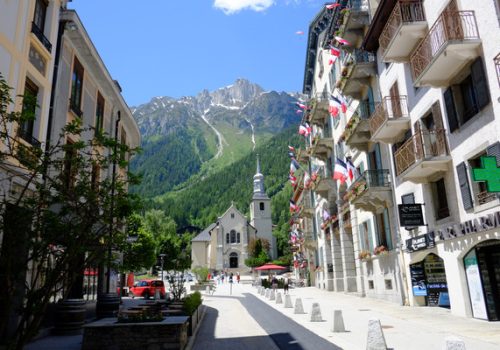
Your trip starts on arriving at your hotel in Chamonix. This is an Alpine centre like no other, bustling in Summer with trekkers, mountaineers and tourists passing through. Enjoy dining out at restaurants in the town centre.
Hotel in Chamonix (breakfast)
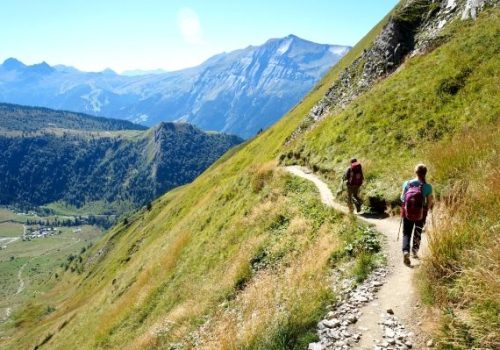
Blue 2 (grade)12.5km with 310m ascent, 950m descent
On your first day, there is time to make last-minute adjustments to kit and to buy food for the day ahead. You’ll catch the local bus or train to Les Houches, where the TMB meets the valley. Start with the Bellevue cable car up to Col de Voza. Then the normal TMB route drops through Val Montjoie, but an optional high route takes wilder paths over Col de Tricot if the group feel up to it. Arrive in the French resort village of Les Contamines.
Hotel or guesthouse in Les Contamines (dinner and breakfast)
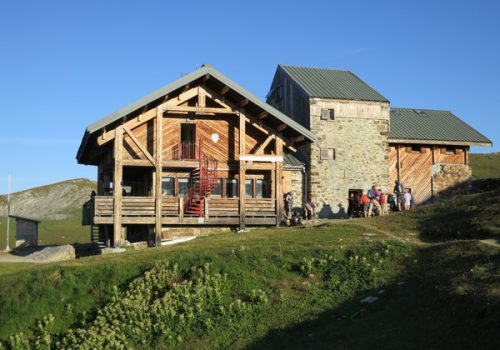
Red 4 (grade) 19.7km with 1350m ascent, 960m descent
Today’s stage is one of the toughest of our Highlights trip, with an ascent to the Col du Bonhomme, where extensive views open out across the Beaufortain Alps, before a traverse to the Col de la Croix du Bonhomme at 2,483m. These high slopes often hold snow early in the season. Descend to the valley of Les Chapieux, and take a taxi to your hotel in nearby Bourg-Saint-Maurice.
Taxi to Hotel in Bourg St Maurice (dinner and breakfast)
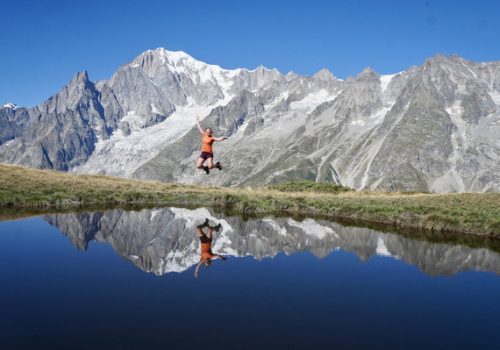
Red 4 (grade) 21km with 1060m ascent, 970m descent
Take a taxi back to the TMB trail at Ville des Glaciers and start the climb to the Italian border at the Col de la Seigne (2516m), from which Mont Blanc is suddenly revealed again. Descend past the glaciers and rocky spires of the Italian side of the Mont Blanc massif to the roadhead at La Visaille, for a bus ride to Courmayeur, in many ways Chamonix’s Italian counterpart.
Hotel in Courmayeur (breakfast)
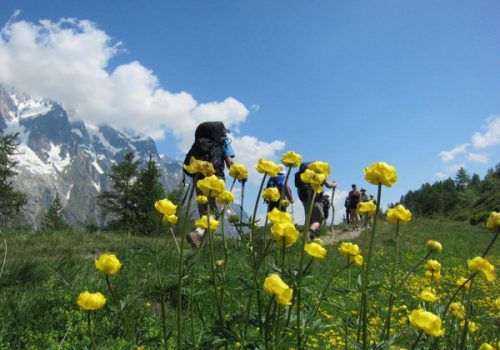
Red 4 (grade) 17.1km with 1170m ascent, 620m descent
Today’s stage is one of the most spectacular on the trail. After a steep climb out of Courmayeur, we follow a traverse of the hillside with stunning views towards the glaciers across the valley. In good weather, we also recommend a harder variant route, a spectacular but long day over the Mont de la Saxe. Drop to the bus stop at Arnuova to return to Courmayeur for the night. (or, take a rest day exploring Courmayeur, or to take the cable cars up into the Mont Blanc massif.)
Hotel in Courmayeur (breakfast)
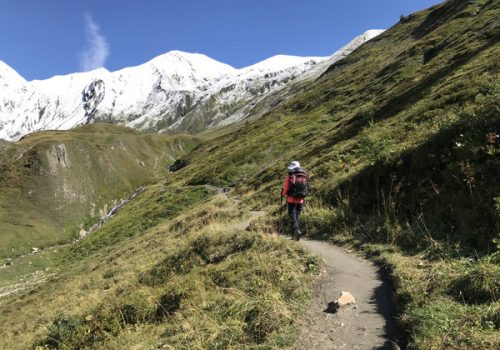
Red 3 (grade) 15.3km with 810m ascent, 980m descent
Switzerland beckons today! Leaving Courmayeur on the regular bus up the Italian Val Ferret, our challenge today is the crossing of the Grand Col Ferret (2537m), often holding snow, and then a long descent into the Swiss Val Ferret. We cross another linguistic and cultural frontier. Reaching the small village of La Fouly, we take to the bus again to skip a long valley stage.
Hotel in Champex (dinner and breakfast)
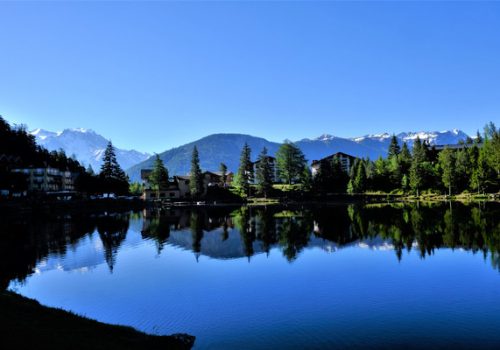
Red 3 (grade) 15.9km with 730m ascent, 920m descent
Walk among meadows and woods to Trient, taking the option past Bovine Alp. This is one of the most scenic stages with long views to the Rhone valley. We pass Col de la Forclaz and drop to Trient, taking a taxi back to the Chamonix valley in the small town of Argentiere. (A harder alternative, at our Black grade, crosses the Fenetre d’Arpette, a narrow col with exceptionally steep and rocky ground either side.)
Hotel in Argentiere (dinner and breakfast)
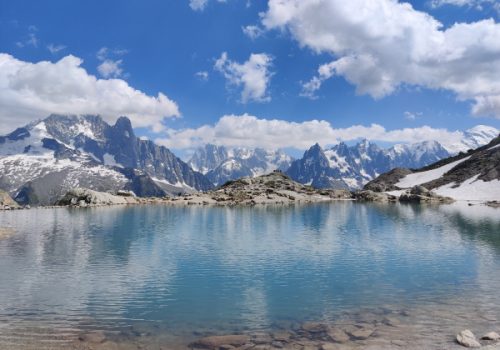
Red 4 (grade) 15.3km with 1390m ascent, 540m descent
From Argentiere, our final day takes to the rocky hillsides of the Aiguille Rouges on the North side of the Chamonix valley, directly opposite Mont Blanc. Our route detours from the main Tour du Mont Blanc trail to visit the famously picturesque Lac Blanc, with its spectacular view of the rocky peaks above Chamonix, before traversing the Grand Balcon Sud to Planpraz. Take the cable car down to Chamonix to celebrate in style!
Hotel in Chamonix (breakfast)
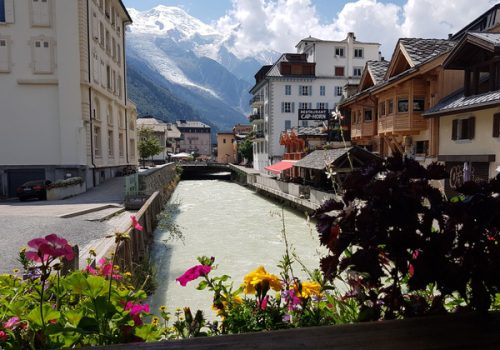
Relax over breakfast, see more of Chamonix and depart for Geneva Airport. If embarking on further travels please ask us to advise, whether in Switzerland or elsewhere in the Alps. Congratulations!
Trip Options
Please join our guided Tour du Mont Blanc Highlights trip:
Please join our guided Tour du Mont Blanc Highlights trip:
Our scheduled guided Tour du Mont Blanc Highlights trip is composed of 7 walking stages and 8 nights accommodation. The maximum group number at any one point will be 8 clients to 1 Alpine Exploratory Inernational Mountain Leader.
Although the walking dates on our scheduled guided trips are fixed, we’d be very happy to book extra nights in Chamonix before or after your trip for you to explore the area a little more. Please do just ask for more details.
We would be delighted to plan a privately guided trip for your family or group of friends at any time within our walking season. We will find you a guide and book your accommodation on the dates you choose. You will have full flexibility over the length of your trip, your choice of accommodation and your dates. Please see our self-guided page for full details of the options available.
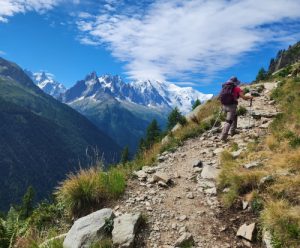
Prices
|
|
Comfy |
|||
|---|---|---|---|---|---|
7stages 2025 Trips |
Private trips only |
GBP 2,220 |
Private trips only |
||
7stages 2026 Trips |
Private trips only |
GBP 2,320 |
Private trips only |
Accommodation
Where we stay
On our scheduled guided trip, we book our classic mix of accommodation which aims to give an enticing taste of Alpine life, staying in comfortable hotels along the TMB trail and in Bourg St Maurice. As standard our trip includes 8-nights in private rooms. We have worked with the hotels on your itinerary for many years, and have come to know some very comfy, friendly and accommodating places to stay.
Single Room Supplement
If you are a solo hiker, or if you would like to stay in single rooms rather than sharing a double, twin or triple room with your friends, we add our single room supplement to the overall trip price. This covers the additional cost of booking single occupancy rooms. The single supplement is only applied to nights where single rooms are available.
Private guided trips only
On our private guided trips, we can customise your trip to make the accommodation more hutty or more comfy to suit your preferences. We can also add an extra rest day if you’d like to spend more time on the trails. Please just let us know your preferences!
Please note we cannot customise our scheduled guided trips.
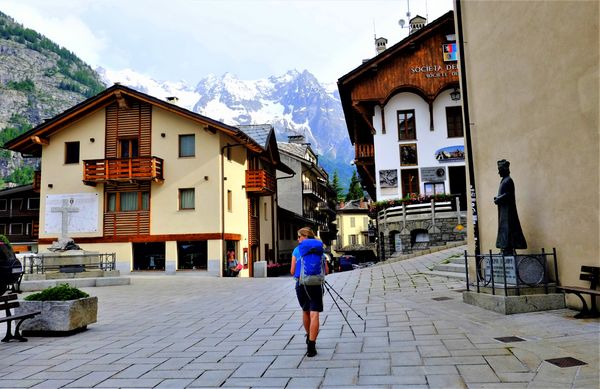
The Route
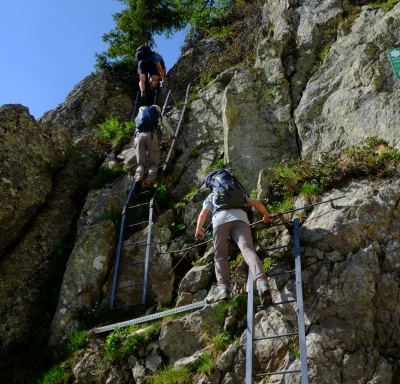
Our routecards stick to the generally accepted Tour du Mont Blanc anti-clockwise route, with some small and scenic diversions such as that to Lac Blanc for views across to Mont Blanc. We have been walking the route regularly since our first visit in 2005 and we think that many of the variants are worthwhile additions to a Tour. Multiple options are outlined on your daily routecards, allowing you to pick your preferred route as you go, depending on weather conditions and how you feel on the day.
The Terrain
The Tour du Mont Blanc is a very popular trail in Summer, and the quality of the footpaths reflects this. The terrain covered can sometimes be steep and rocky, but mostly the uphill sections are long gradual tests of stamina on good trails. This is complemented by the more relaxing sections of wide tracks through forests, country lanes and zig-zagging hillside paths with some rockier sections to keep you entertained.
There are some small sections of steep, loose ground requiring care, and in a small number of places on the trail you meet with ladders and other aids, such as fixed chains. These should not present a problem to regular mountain walkers and are not via ferrata or climbing sections. All such areas can be avoided by following alternative routes given in your routecards, though these alternatives are sometimes longer. In early or late summer, there is a good chance of snow patches lying on the higher paths which will require care, but the lower paths are likely to be snow-free. We provide as much information as we can on snow in our pre-Summer Season Update.
Is it for me?
The Tour du Mont Blanc is a famous trail, often classed as one of the best long-distance hiking trails in the world, and understandably so. The route has a varied mix of accommodation suiting most tastes. It has high rocky passes for a high mountain feel, its villages are characterful, it offers hearty food and it gives delightful walking in the most grand scenery. The result is a tough yet enjoyable holiday and a true taste of Alpine life.
The Tour du Mont Blanc is good for those who have a good overall fitness, some experience of multi-day hikes in the mountains, and the ability to walk for up to 8 hours per day over rocky and sometimes exposed ground. If you are very fit and active day-to-day, then the TMB can also be suitable for those new to multi-day trekking, but good walking experience is still needed. The main challenge of the TMB, aside from the daily distance, is the amount of ascent and descent. Most days comprise a steady ascent to a mountain pass, followed by a descent to the valley bottom and your home for the night.
The route is generally well signposted and waymarked, aiding navigation, although a map and compass will be needed for navigation in case of bad weather, such as low cloud. It is essential that at least one person in each group can navigate with a map and compass. We provide you with our routecards, providing detailed descriptions of each days’ walk, along with the topographical maps for the full route.
Difficulty
We grade the Tour du Mont Blanc as a Red 3. The TMB is first and foremost a walk and there is no glacier crossing, via ferrata or rock climbing. There are, however a few sections of steep and rocky ground which require steady foot placement and, at times, an ability to cope with walking along some narrow and possibly exposed paths. In particular there are sections on the standard route, all on the final stage above the Chamonix valley, where metal ladders or steps have been installed to make the route easier across rocky ground. These sections can be avoided by alternative routes, but should not present problems to regular hillwalkers.
We explain in your routecards the relative difficulties of the route and the variants. (We try to show relative difficulty so that hikers can make the right choices.) As noted above, beside the distance walked each day, the main challenge is the ascent and descent. Although it is possible to shorten some days by selecting different stopping points, the distances are generally dictated by the location of the accommodation along the trail. Some days can be shortened by taking buses and cable cars and your routecards advise where this is possible. Please ask us for more details!
 Tour du Mont Blanc Walking Guide – more about the trail
Tour du Mont Blanc Walking Guide – more about the trail
 The making of our Tour du Mont Blanc – photos from our research trips
The making of our Tour du Mont Blanc – photos from our research trips
Travel Information
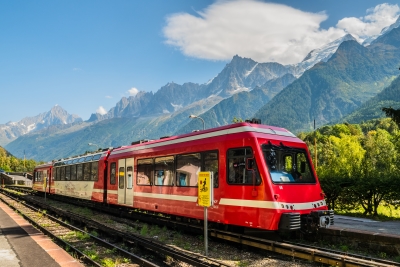
How to get there
Your holiday starts and ends in the major Alpine resort of Chamonix, one of the best-linked in the Alps. The most convenient airport is Geneva. Several minibus companies offer transfers from the airport in about 1h 30m, or take the coach or (longer) the scenic Swiss trains via Martigny. Also from the Swiss side, Zurich and Basel airports work but with longer train journeys.
Travel to and from the trip is not included in the holiday price, and we leave you to arrange your transfers individually. We do however take care to give the most useful notes possible about all travel options. We supply these both on booking in your Trip Notes, and in your info pack which we send out prior to your trip. We also offer personalised tips based on our extensive travels across Europe; please ask us for advice and we’ll be happy to help.
What's Included
Included:
- 8 nights of accommodation
- An Alpine Exploratory International Mountain Leader
- Breakfast every morning
- Dinner on 4 nights (subject to change) - in Les Contamines, Bourg St Maurice, Champex, Argentiere
- Cable car to Bellevue and taxi journey from Trient to Argentiere and return taxis from Les Chapieux to Bourg-Saint-Maurice
- Baggage transfers (1 bag per person as standard, to all stops except the huts - strict weight limit of 15kg)
- An overview topographical map of the route
- Expert advice and local information
- Full support during your trip from the Alpine Exploratory team (9am until 9pm in the Alps)
Not Included:
- Travel to and from your trip
- Local transport whilst on the trip unless specified
- Travel insurance
- Lunches, snacks, drinks and evening meals in Chamonix, Courmayeur and Argentiere
Contact Us
If you have any questions about the Adlerweg trip, feel free to reach out to us. We’re happy to help!

 TMBg1 5 to 13 July 2025
TMBg1 5 to 13 July 2025

